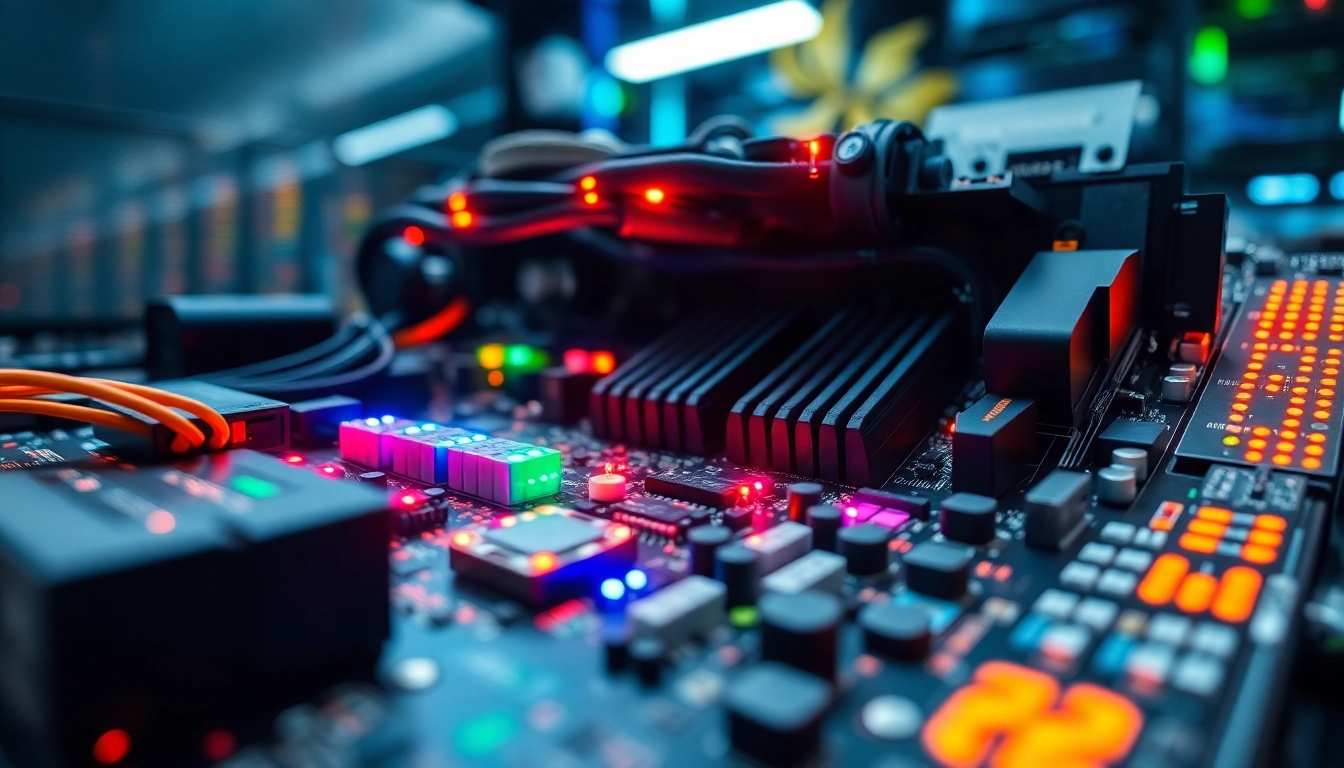1. Introduction to the Key Components of a Server
Building a robust and efficient server infrastructure requires an in-depth understanding of its fundamental components. These components work together synergistically to ensure the server operates effectively, handling demanding workloads, providing reliable uptime, and supporting scalable growth. For organizations seeking to optimize their IT framework, the topic of componente server becomes essential, offering insights into selecting, integrating, and maintaining high-performance server hardware.
1.1 What Is a Server Component and Its Main Function
A server component is a vital hardware or software element that contributes to the overall functionality, performance, and reliability of a server. These components include processors, memory modules, storage drives, network interfaces, power supplies, and motherboard circuitry. Each element has a specific role—processors execute instructions, memory temporarily stores data for quick access, and storage devices hold persistent information. The primary function of these components is to collectively enable continuous operation, data integrity, and efficient resource management, making them the backbone of any IT infrastructure.
1.2 How Components Integrate for Optimal Performance
Achieving optimal server performance hinges on the seamless integration of its components. Compatibility among CPUs, RAM, storage, and network interfaces ensures that data flows unhindered and workloads are processed efficiently. For example, pairing a high-speed NVMe SSD with a compatible motherboard and a dual-port 25Gb Ethernet controller minimizes bottlenecks, leading to faster data access and network throughput. Additionally, employing enterprise-grade power supplies and cooling systems maintains stability under sustained loads. Modern servers often leverage modular architectures, allowing scalable upgrades and targeted replacements without extensive downtime, thus maintaining high availability and resilience.
1.3 Trends in Server Components for 2025
Looking ahead to 2025, several trends are shaping the evolution of server components. These include the adoption of AI-optimized processors, increased integration of high-speed interconnects such as 400Gb Ethernet, and advanced storage technologies like persistent memory modules. Moreover, energy-efficient components, including low-power CPUs and power supplies rated for higher efficiency certifications, are gaining prominence. Virtualization-aware hardware and embedded security modules embedded directly into components are also emerging, aiming to enhance security and flexibility. These advancements collectively prepare IT infrastructures to meet the exponentially growing demands of data centers, cloud deployments, and AI workloads.
2. CPUs and Memory: The Heart of Server Components
2.1 CPU Selection Based on Workload Type and Efficiency
The Central Processing Unit (CPU) remains the core processing engine within a server. Its selection significantly impacts overall system performance. For tasks requiring high computational power, such as scientific simulations or AI training, multi-core, high-frequency processors like Intel Xeon Gold or AMD EPYC series are ideal. Conversely, for light workloads, energy-efficient CPUs with lower TDP values suffice, reducing power consumption and heat generation.
Data centers often evaluate CPUs based on core count, clock speed, cache size, and support for features like simultaneous multithreading (SMT). Choosing CPUs with integrated accelerators or AI-specific instructions can further enhance performance for specialized applications. For example, the Intel Xeon Platinum 8164 with 26 cores and 2.0 GHz supports demanding workloads with high concurrency, while also maintaining power efficiency.
2.2 Types of RAM and Their Impact on Server Speed
Memory modules directly influence server responsiveness and multitasking capabilities. Server-grade RAM typically includes features such as error-correcting code (ECC) for data integrity, and support for high speeds like DDR4-3200 or DDR5-4800, depending on the motherboard.
Faster RAM reduces latency and improves data throughput, making it essential for applications with intensive data access, like databases and virtualization environments. Moreover, increased capacity—such as 128GB or more—enables handling larger datasets and reduces swapping to disk, which can bottleneck performance.
2.3 Comparative Analysis: Intel vs. AMD Processors for Servers
Intel Xeon and AMD EPYC processors dominate the server CPU market, each with distinct advantages. Intel CPUs, such as the Xeon Scalable series, are renowned for their mature ecosystem, extensive software optimization, and high single-thread performance. AMD’s EPYC series offers higher core counts, better price-to-performance ratios, and advanced features like Infinity Fabric allowing efficient multi-CPU configurations.
Case studies indicate that AMD EPYC processors often outperform Intel counterparts in multi-threaded workloads, making them suitable for dense virtualized environments. However, Intel’s long-standing presence ensures broader compatibility and ecosystem maturity, factors crucial for enterprise-grade deployments.
3. Storage Systems and Their Role in Server Components
3.1 SAS, SATA, and NVMe Hard Disks: Advantages and Applications
Storage drives are fundamental to data persistence, speed, and capacity. SAS (Serial Attached SCSI) drives excel in mission-critical enterprise environments, offering high reliability and faster data transfer rates (up to 12Gb/s). SATA (Serial ATA) drives are cost-effective and suitable for archival or less performance-sensitive applications, typically offering speeds up to 6Gb/s with larger capacities.
NVMe (Non-Volatile Memory Express) SSDs revolutionize storage with ultra-low latency and high throughput—often exceeding 3GB/s—making them the preferred choice for applications demanding rapid access to data, such as real-time analytics and high-frequency trading.
3.2 Configuring RAID for Redundancy and Speed
RAID (Redundant Array of Independent Disks) configurations enhance performance and data protection. RAID 0 stripes data across disks for maximum speed but offers no fault tolerance. RAID 1 mirrors data for redundancy, while RAID 5 and RAID 6 combine parity with striping for scalability and fault tolerance. Enterprise servers often employ hardware RAID controllers like the Broadcom MegaRAID 9440-81, which ensures low latency and high reliability.
3.3 Storage Innovations for 2025
Emerging storage trends include persistent memory modules like Intel Optane DC Persistent Memory, which merge memory and storage, reducing latency significantly. Cloud-native storage solutions are also integrating NVMe over Fabrics (NVMe-oF) to extend high-speed access over networks, facilitating scalable, distributed storage architectures vital for hybrid clouds and edge computing.
4. Motherboards, Power Supplies, and Connectivity
4.1 Critical Features of a Server Motherboard
The motherboard acts as the backbone of server hardware, integrating CPU sockets, memory slots, PCIe expansion slots, and network interfaces. Key features include support for high-speed buses like PCIe Gen4 or Gen5, multiple DIMM slots for memory scalability, and robust power delivery systems to handle high-performance CPUs and GPUs. An example is the Dell PowerEdge R640 motherboard supporting dual processors and extensive I/O options.
4.2 Selecting Reliable and Efficient Power Supplies
Power supplies must deliver stable, efficient power with high wattage capacity and certifications such as 80 PLUS Platinum or Titanium. Redundant power supplies ensure continuous operation even during failures. Modular units facilitate cable management and airflow, crucial in densely packed data centers.
4.3 Network Interfaces and Controllers for Peak Performance
High-performance servers utilize multi-gigabit network interfaces—such as 10Gb, 25Gb, or even 100Gb Ethernet cards—to handle large data transfers. Advanced controllers like the Broadcom XXV710-DA2 Dual Port 25Gb SFP28 optimize network throughput and reduce latency, supporting demanding workloads like virtualization, big data, and cloud services.
5. How to Choose the Best Server Components for Your Business
5.1 Needs Assessment and Compatibility Checks
Determining the right components begins with analyzing workload requirements—whether for web hosting, virtualization, or data analysis. Compatibility checks between CPU, motherboard, memory, and storage are critical. Consulting vendor specifications and compatibility matrices ensures seamless integration and future scalability.
5.2 Integrating Components for a Scalable Infrastructure
Designing for scalability involves selecting modular hardware systems that can be upgraded or expanded as needs grow. For instance, deploying servers with hot-swappable drives and PCIe slots allows on-the-fly upgrades without extensive downtime. Virtualization-ready hardware supports multiple workloads on shared resources, optimizing costs and performance.
5.3 Maintenance and Updating of Components in Enterprise Environments
Proactive maintenance includes routine hardware diagnostics, firmware updates, and component swapping before failures occur. Employing management tools like iDRAC or iLO enables remote monitoring and control. Staying informed about technological advancements ensures timely upgrades, keeping infrastructure competitive and secure.



